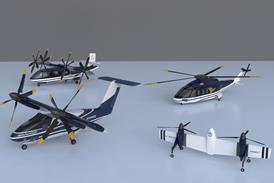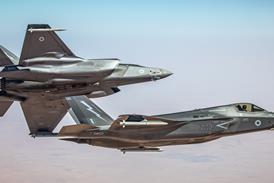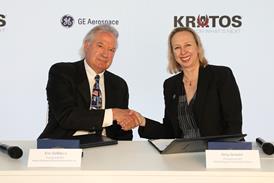US aviation and wildlife experts have discovered grounds for mutual worry: increasing air traffic from two very different winged objects - aircraft and birds.
Faced with the potential danger of aircraft collisions with flocks of wild geese, seagulls and even vultures, many US airports have declared war on the feathered frequent flyers.
The amount of damage that one bird can do to an aircraft is incredible: if an aircraft flying at 260kt (480km/h) collides with a 3.17kg (7lb) bird, for example, the impact equals 2t of force. One estimate says that bird strikes in the USA cost $400 million a year in damage and lost time to aircraft.
In January, 1998, a Delta Air Lines' Boeing 727-200 hit a flock of geese (each weighing an average of 3.17kg) on its ascent from Houston Intercontinental Airport. Power was lost in one of the three engines and cockpit instruments failed. The crew managed to fly the aircraft back to the airport, but post-flight checks revealed the radome was destroyed, two engines had to be replaced and the right wing and other parts of the aircraft were badly damaged.
Because there were nearly 5,000 bird strikes last year, some airports are adding an arsenal of anti-avian weapons such as traps, tranquilliser guns, shotguns and even paintball guns and radio control cannons.
But with birds getting used to the onslaught, a new array of exotic weaponry, such as lasers, sound waves and deterrent chemicals, is being deployed. The latest weapon from China is a screaming loudspeaker mounted on a truck and appropriately nicknamed Godzilla because the noise can be heard as far away as 11km (7 miles).
Radio-controlled chase planes
In some airports, flocks of nesting birds have been chased down by radio-controlled model aircraft and in others, by collies. Wildlife experts at airports in Illinois, Oregon and Nebraska have captured hawks and other raptors, and transplanted them in wild habitats several hundred kilometres away. Despite such efforts, many raptors flew back to their favourite nesting sites at the airports.
The cost of bird eradication is significant. In Amsterdam, the airport budget for bird control exceeds $1 million. In Vancouver, there are 14 full-time employees paid to keep seagulls, pelicans and geese out of the way of air traffic.
At New York's Kennedy Airport, $350,000 a year is being spent on raptor control, while in Minneapolis a staff of six - plus paid consultants - spends over $110,000 a year to kill geese, scare off birds and trap wild creatures.
The total being spent to rid the airports of their avian visitors is not known because at smaller airports the task is hidden in the maintenance budget. At the same time, many airports contract with the US Department of Agriculture or US fish and wildlife experts to conduct studies and direct the elimination of birds and other wildlife. But the sum easily runs into millions of dollars.
Even so, some airports are not doing enough. A special panel has recommended that the US Federal Aviation Administration do much more, including the development of wildlife hazard management plans and mandatory bird strike reporting. While the FAA acknowledges the problem, it rejects a push to force airports to report birdstrikes, claiming it would be too difficult to enforce.
Delaying action
Paul Eschenfelder, director of airline pilot safety for the Air Line Pilots Association (ALPA), contends that some major airports are not doing enough. He believes they are delaying action by calling for wildlife assessment studies. "Many airports have ongoing wildlife problems that have not been addressed," he says.
He points to Kansas City International Airport, where dozens of raptors were roosting. Over the past two years, 600Ha (1,500 acres) of airport property has been treated with zinc phosphide to kill the rodents they fed on, and as a result there are fewer hawks, owls and harriers living around the airport. At $6,000 it was inexpensive and quickly solved the problem, Eschenfelder says.
In early August, an international group of civilian and military aviation and wildlife experts met in Minneapolis for three days to look at new ways to tackle the problem. The 400 people attending the Bird Strike Committee USA/Canada were warned that the problem is going to get worse. In particular, numbers of migrating Canadian geese are on the rise.
Eschenfelder says the $300-400 million a year cost of birdstrikes in the USA could rise as high as $1 billion if it included all civilian and military bird strikes worldwide.
In the last 10 years around 90 people have been killed in the USA in aviation accidents involving collisions with birds, he said, and 300 have died worldwide in the last 15 years. The FAA estimates that collisions with aircraft by wildlife - including deer, geese, gulls and raptors - rose from 1,700 in 1990 to 4,900 in 1999.
What makes airports particularly attractive to birds is their proximity to water and the large grasslands either on the airport property or adjacent to it. According to the latest research, at least 80% of all aircraft collisions with birds and other wildlife, particularly deer, occur at or near airports.
James Cooper, a biologist with the University of Minnesota, says efforts to control the geese at Minneapolis airport have led to a 20% decline in those birds. One of the most effective control methods has been trapping. Workers spend 12 to 14 hours a day killing thousands of trapped geese and the meat is processed and given to the needy. Birds are also shot and nests destroyed but these methods have not been as effective as trapping, Cooper said.
Airports face criticism and lawsuits from environmental groups concerned about the trapping and shooting. "The public is sensitive to killing birds," says Bradley Blackwell of the National Wildlife Researcher Center in Minneapolis, who is leading research into scaring geese with laser beams. The experiments have been effective with ducks and geese, but not with other birds such as starlings.
At Portland International Airport, officials experimented with a commercial spray-on bird repellent called FlightControl that gives geese an upset stomach and changes the colour of grass to make it unappealing. Portland airside operations specialist Sharon Gordon says application of the chemical deterrent - which costs $175 a gallon - on a 20Ha test plot was effective for at least two weeks.
Other airports are using border collies to chase off flocks that have lost their fear of noise-makers. "Many of these birds, especially large-bodied sandhill cranes, had become habituated to the noise-makers," says Bobby Orick, who works for the Southwest Florida Airport in Fort Myers. Since the border collies entered service last year, no sandhill cranes have nested at the airport, Orick says, and the presence of wading birds, crows and blackbirds was reduced, resulting in fewer birdstrikes.
Eschenfelder says aggressive programmes have reduced wildlife and bird strikes significantly. At Kennedy Airport, gull strikes have dropped by more than 75% and all birdstrikes at Chicago O'Hare are down by 70%.
Radar system
The FAA has spent $1.6 million over several years developing a radar system to forecast and monitor bird activity. The Avian Hazard Advisory System has been operating in the eastern one-third of the USA since March. About 2,000 low-level routes, ranges, airspace and military airfields are evaluated every hour.
Demand is increasing worldwide for access to information developed by the US Air Force for its Bird Aircraft Strike Hazard system. It has identified over 60 bird species most hazardous to flight operations with hundreds of environmental variables and aeronautical charts incorporated into the system.
For its part, ALPA is urging Congress to authorise spending $600,000 a year to undertake wildlife surveys at airports and $450,000 to reduce bird and animal hazards and manage the FAA's wildlife strike database. "Flightcrew members should receive formal education on wildlife hazards during their annual recurrent training, along with guidance on how to reduce these hazards," ALPA says.
At the same time, the pilots' group is critical of the FAA for its bird ingestion test requirements on jet engines. ALPA points out that, while the FAA does require tests for the ingestion of small, medium and large birds, its proposed new rules do not address increases in the bird population and flight activity.
Even with all the efforts at airports, some experts are calling for dramatic cuts in the geese population during the hunting season.
Source: Flight International























